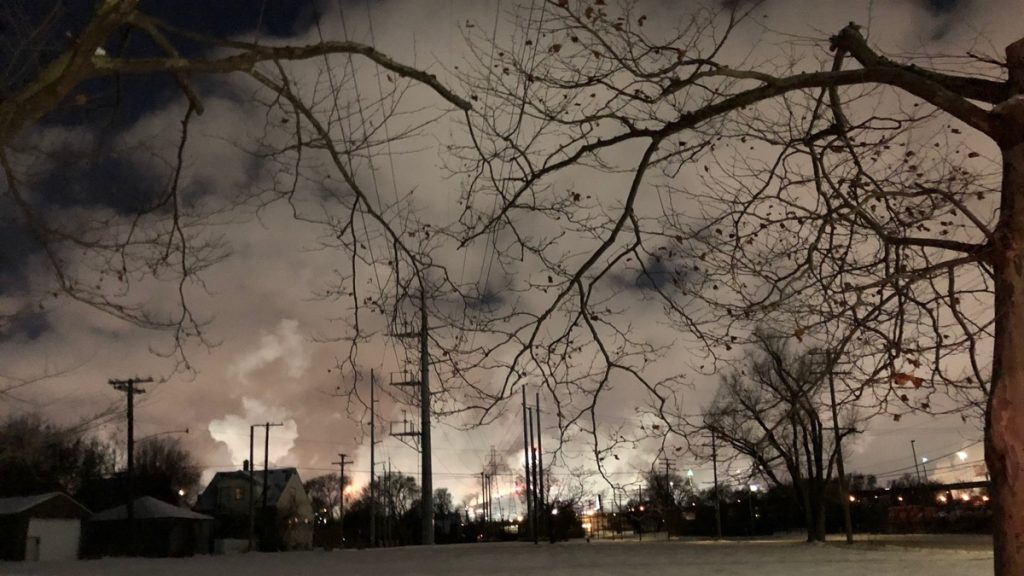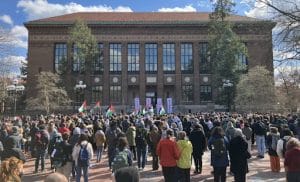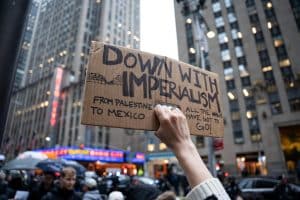Oftentimes, racism and environmentalism are thought of as separate issues. Since the Black Lives Matter uprising of last summer, however, there has been a growing awareness of the scope of racism and its existence in every facet of society. The legacy of racism, dating back to the enslavement of Black people in this country, is woven into the fabric of American society. It has existed in many forms on structural and personal levels, including racist real estate practices such as redlining and restrictive covenants, as well as discriminatory employment practices. Not to mention how Black folks are criminalized, brutalized, exploited, and killed by police and the prison industrial system. The list goes on, and it also includes being more vulnerable to environmental pollution.
During the past five years, I have been volunteering with Emma Lockridge, an environmental activist, organizer, and resident of Detroit 48217, a predominantly Black zip code that is home to over three dozen polluters emitting toxins into the air, not to mention a highway and tanker trucks going up and down neighborhood streets every day. All these air polluters have made Detroit 48217 the most polluted zip code in Michigan, and as a result residents suffer from disproportionately high rates of asthma, cancer, and brain damage, as well as other negative health impacts tied to air pollution. Chief among the polluters is Marathon Petroleum’s massive tar sands oil refinery, taking up 250 acres, producing up to 140,000 barrels of oil a day, and spewing 29 different toxins into the air by the ton, toxins such as nitrous dioxide, sulfur dioxide, and carbon monoxide. It also emits eight types of carcinogens, including benzine and dioxin. No one grows vegetables or has fruit trees anymore because the soil has high levels of arsenic and lead.
Those who wish to leave the polluted community cannot afford to do so because their home values are declining. For the past eight years, members of the Boynton neighborhood have made it their mission to fight for a buyout from Marathon Petroleum. What is happening in these communities epitomizes the indifference and cruelty of companies under capitalism: putting profit before Black lives.
A Sacrifice Zone
“The bottom line,” says Emma Lockridge, “is they really do not care if we live or die. They just don’t care. The only thing they care about is the handshake and the money. And what reflects the money being made. We’re just collateral damage in the money-making machine.”
In Steve Lerner’s 2012 book Sacrifice Zones, the author visits various cities across the U.S. plagued by the same problem as the Boynton community. Sacrifice Zones are areas where a factory, refinery, or some other industrial polluter sits near a residential area and causes irreparable damage to that community. Residents of these communities are most often working-class people of color and working-class whites. As a result, more affluent folks don’t have to deal with the risks to their health and safety. Lerner explains this as environmental racism and environmental classism. In 2012 residents of the majority-white neighborhood of Oakwood Heights did receive a buyout, while Emma’s majority-Black neighborhood right next-door did not. Therefore, people of color are chiefly at risk, not only because of a disregard for Black lives, but also because the legacy of segregation is still embedded in the city. Just as real estate agents once discriminated against Black people wanting to settle in Detroit by confining them to inadequate housing via redlining and restrictive covenants, polluting industries settle and expand near poor neighborhoods with people of color because they lack political clout. This means that it is harder for them to raise awareness and more difficult to sue these companies and hold them responsible for the damage they cause.
In the Boynton neighborhood, which is badly polluted and where Black people are disproportionately arrested, Black lives are seen as collateral damage, the means to an end, the “end” being a variety of things from profit for corporations to providing energy to homes, etc. Black people’s bodies are still being stolen and used for capitalistic gain, whether that means using prisoners for free labor or poisoning Black folks with pollution. Environmental racism is only one aspect of the system continuing the legacy of racism in the U.S.
Emma Lockridge’s Story
“I was born in 1953 in Florence, Alabama,” Emma says. “And it was during the height of the Jim Crow era. My birth certificate says I’m colored. The hospital was segregated. When I was born, segregation in the South was in full effect. That’s how my life started, in the ground zero area of the civil rights movement in Alabama. I now identify as Black, with a capital B.”
When she moved to Detroit, her stepdad, having been employed at Great Lakes Steel, was working on the polluted Zug Island, an industrialized island in Emma’s zip code. “When I was a little girl [we] used to come pick him up,” she says. “And it would be so frightening.” She tells me he died in his 40s. “I do not believe he would have died so young if he had not worked out there. The lady across the street also worked on Zug Island, and she died in her 40s of cancer.”
Because of the refinery’s humble beginnings, Emma grew up unaffected by the refinery’s sulfuric smell that fills the neighborhood today. She went to Cass Technical High School in Detroit, where her career as an activist began. Cass Tech was a huge influence on her life. It trained her for her role as an activist and organizer. It encouraged her to question and challenge the things and people before her rather than just accepting how things are. She participated in many walkouts, one of which changed the dress code for all Detroit Public Schools to allow girls to wear pants instead of only skirts and dresses.
As an adult, after living in New York for about eight years, Emma and her daughter moved back to Detroit to live with her mom. Emma got an apartment in Lincoln Park, a nearby suburb, after her daughter went away to college, where she remained for several years. And it was in this high-rise apartment that she would first notice the pollution affecting the community she had lived in and that her mom still lived in. “I could see all the pollution growing over Mom’s home every day,” she says. “And I was like, my God. I started photographing it, like, well, if it’s going over like this daily, what’s happening in those houses?”
When her mom grew older and began having trouble living on her own, Emma decided to come live with her to help her out. “And when I got there, oh my God. It was like living in a refinery. It was like everything I thought it would be. It was like, Why do they have people living in this situation and not fighting it? They’re poisoning people in their homes. And I found out firsthand. I think if I hadn’t moved in there, nobody would’ve ever said anything.”
Over time, the little building that you could only smell when you drove right next to it grew to become what Marathon is today, a huge industrial complex. “The difference now is we live in it. It has overwhelmed and engulfed the community, if you will. We are part of it. It is not an extension of the community; we are part of it. It is the community. It defines who we are.”
Activism
Her fight against Marathon and her role as an activist began long before she began working for Michigan United, a local nonprofit, as an environmental justice organizer. When she moved back in with her mother to help care for her, she continued photographing the pollution and began organizing her neighbors to gather outside the refinery with protest signs. “I’ve been calling attention to it since the moment [I moved in],” Emma says. “Even before I got there. I started posting pictures of the pollution on Facebook. Look at this! Look at this! People were like, whoa. And it’s been my mission now to get up out of there. And get others — save the other people too. Not just myself. But we need to — they need to — do the right thing. And stop poisoning people.”
Emma became known as a “troublemaker” by some members of her community for, in their eyes, getting their neighborhood labeled as polluted. “Really?” she says incredulously. “You think I got that kind of power? And by the way, if it’s true, it’s just true.” While there were folks who disagreed with what she was doing, others rallied behind her, eager to fight for their community’s health.
When she became an environmental justice organizer at Michigan United, they helped her raise awareness about what was happening to the community. The organization held an annual event they called Capitol Day, in which citizens could visit their representatives and talk about problems going on in their district.
But Emma knew she needed to do more to pressure Marathon. In 2018 she organized a group to attend a stockholders’ meeting in Ohio to request a home buyout. Emma knew it was important to bring her issue to the attention of stockholders because the company seemed to care more about the them than the people whose community they had polluted, as was evident during DAPL protests. When they showed up, some remained outside to protest while Emma entered the meeting to make comments during the open microphone session. During the meeting, she directly requested a meeting with then chairman Gary R. Heminger. It would take another two years for a meeting to lead to a buyout.
Where Things Stand
On December 17, 2020, Marathon announced a $5 million buyout to purchase the homes of residents near the refinery. Residents will be offered a base price of $70,000 to move somewhere with cleaner air, plus half their home’s appraised value. The area will be turned into green space, a buffer zone between residents and the refinery. Emma has already begun packing up her things. She tells me she’ll be moving to Memphis to be near her daughter. She will finally get the rest she deserves somewhere away from Marathon’s fumes.
Emma and her community put years of hard work into their fight for home buyouts. But this is only a small victory. Marathon continues to poison the community..
Capitalism is an insidious beast that fuels racism and inequality. Companies strive to make a profit, and as shown by the plight of the Boynton neighborhood, they will do anything it takes to make that happen. That includes poisoning people, polluting the planet, incarcerating people for free labor, and, at its core, exploiting workers. In some cases, these companies will make concessions, such as home buyouts, to preserve their image. The reason they gave into these demands was that they knew Emma and her community would never give up fighting; they would never stop telling their stories. Even after this partial victory, they won’t stop. “I might end up talking about this till my last breath,” Emma says. “I can’t let them off. Because sometimes I get tired, and I’m just like, ‘I’m just going to be done with this, and I’m just going to move on.’ You know what? Even if I moved on, if I left here today, I would talk about them the rest of my life. … What they’ve done and what they’re doing … I would never stop.” And we can’t stop telling these stories, because we can’t afford to.
Acknowledgments
Thank you to Amy Jones for recording beautiful footage of an interview for later transcription. Thank you to Graham Cassano and Terressa Benz for guiding me through this research process. And of course thank you Emma Lockridge for telling me your story so it could be written down for others to know.










